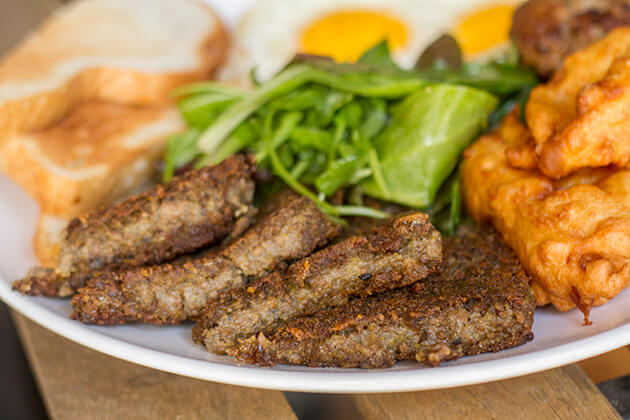Scrapple: The Best Meat That You’re Not Eating… Yet


Scrapple from Delaware and Hudson
photo by Jane Bruce
The first time I saw scrapple on a menu, I was intrigued. But when I asked for a definition, I was disappointed. “Scrapple is pork mush,” said my dining companion. While I have always been a major fan of pork, mush reminds me of prison food in movies. And no one would voluntarily eat movie prison food, which I imagine is even worse than real life prison food.
But as it turns out, this so-called pork mush is turning up on menus left and right. Originating from German settlers in Pennsylvania, scrapple was once a product of necessity. The cooks would take leftover scraps of meat—anything from the pig’s tongue to its liver and brain— and bulk it up with cornmeal and spices. Then it was boiled (until, I assume, it was pretty dry).
But today, the scrapple I’ve been finding has not been that grey meat loaf of old. It has transformed into something desirable. Even Ivan Orkin offers a take on scrapple at his Lower East Side restaurant Ivan Ramen. (His team throws it in a waffle iron to make their okinomiyaki.) And now, you can find scrapple in Brooklyn, as well, as forward-thinking chefs who appreciate its versatility and utility bring it to tables all over the borough.
At Delaware and Hudson, Patti Jackson uses what she calls an “old-school style recipe” that’s “rustic and traditional.” In her quaint Williamsburg restaurant, she cooks down cornmeal and buckwheat until they’re cooked to a “mush” and then adds pork hearts and livers, plus sage and plenty of black pepper. Order it with two poached eggs for a brunch that will definitely require a postprandial nap.
Not too far from Jackson’s restaurant is Egg, where you can also sit down for scrapple at breakfast, which is served all day, seven days a week. This scrapple is a mix of bacon fatty onions and pork shoulder with the traditional heart and liver; to keep the cornmeal from drying out the mix, they also add some ham stock. (I’m unclear if they bottle said ham stock, but if they do please get me some.) After the mold has set, they brown the scrapple on the flattop to order. Says Chef Evan Hanczor, “It’s a pretty unfamiliar thing for those not from the PA/Mid-Atlantic scrapple belt, but it’s a great product… we still get exclamations of relief from displaced scrapple lovers who can’t find a decent version in the city.”
If you want to try your hand at cooking up your own scrapple, take a trip to Bed-Stuy to Carolina Country Store, where, amidst coconut candies, Duke Mayonnaise, Scott’s Barbecue Sauce and sage sausages, they serve traditional scrapple by the pound.
Some may find the offally taste of scrapple a little… off-putting. And if that’s the case, you should head to the Meat Hook. Instead of using metallic-y liver and kidneys these expert butchers use head meat—a process Production Manager and scrapple enthusiast Taylor Adams said is “super fun.” To do this they debone a pig head, braise it and use that meat for the final product. After going through a grinder and a mix with cornmeal and spices, they put the scrapple in a mold and let it sit overnight. If you go to the Meat Hook, you can get your scrapple fresh or frozen. Either way, bring it home, brown it up—maybe even top it with a sunny egg and Sriracha—and you’re in for the best “pork mush” of your life.
You might also like 




















